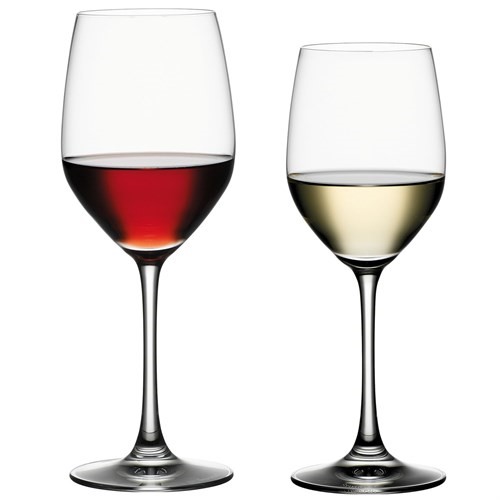Vino In My Dino
Winespeak: Color
July 2, 2015 15:48
Posts this month focus on what I call Winespeak which are terms that sometimes are obvious in meaning and others are not. Today’s word is color.
In the beginning, as the berries develop, they are the same color: green. As they develop color, called veraison, the green pea colored berries turn either purple for red wine grapes or a golden or yellow color for white wine grapes. Color of wine is the first thing you notice when it is poured into your glass. When it is a white wine you have a color spectrum of light yellow to golden brown (this would be leaning toward an older wine). When it is a red you can go from light garnet to deep purple to brownish edged red (also an aged wine). It all depends on the varietal and aging-whether oak or time in the bottle.
White wines often are pale yellow with a tinge of green, just a tinge. As some wines are aged you’ll have a deeper hue of dark gold. Do you know why the wine is so clear? Or have you ever had a cloudy glass of wine? Fining and filtering help clarify the wine so it is clear in your glass. Note: not every winemaker filters wine so educate yourself! The mainstream wines typically are filtered but ask your local winemaker about the process.
Red wines run the gamut of light garnet (think Pinot Noir) to deep purple (Petite Sirah) and many shades in between. As they age, so does the color. Some of the wines from the 1970s I have tried are in the reddish-brown stage. A great way to really see the tones and color of wine is to hold a piece of white paper behind the glass and tilt it away to see the rim of the liquid. Here the background helps to define the color even more.
Enjoy the wine color spectrum as you enjoy your glass of Chardonnay or Zinfandel over the weekend. A toast to red and white wine with a splash in my Dino!

Categories
- COVID
- Follow the Vineyard
- Note from Home
- PairItWithPed
- Pandemic
- pedroncelli
- Port
- Postcards from Home
- Pruning
- Seasons in The Cellar
- Tasting Room
- Thanksgiving
- Vintage Notes
- Winemaking
- Women's History Month
Recent posts
-
91 Years Later
-
Come Over October: It's About Community
-
Come Over October
-
A Legacy Continues!
-
Everything Old is New Again
Popular tags
- Merlot
- Seasons in The Cellar
- COVID Coffee Chat
- Dry Creek Valley
- French Oak
- Library Wine
- Down to Earth
- family
- Habit
- note from home
- newsletter
- 1974 Cabernet Sauvignon
- Holding steady
- Estate Vineyard
- Bushnell Vineyard
- Schotzki
- PairitwithPed
- Oak
- Reserve
- Heat wave
- Mother Clone
- Pruning
- Crop set
- Rosé
- cooking with wine
- Sonoma County
- American Oak
- Cellar Master
- Harvest 2022
- Pandemic
- Sauvignon Blanc
- cheese
- Cookies
- Courage Zinfandel
- Pedroncelli
- COVID19
- Cabernet Sauvignon
- Recipes
- Follow the Vineyard
- Barrels
- Four Grapes Port
- Lake Sonoma
- Homecooking
- food and wine
- Pantry
- OpenThatBottleNight
- Block 007 Cabernet Sauvignon
- Finding Your Roots
- Anniversary
- Easter





